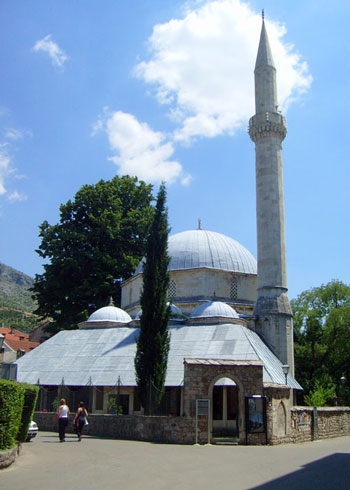
Karađozbegova džamija
Mostar je bogat džamijama, koje su raspoređene u svakom kvartu i pretstavnice su tipičnog otomanskog stila u arhitekturi. Male, ali elegantne, to su struk-ture koje, kako sa arhitektonskog, tako i sa šireg kulturnog stanovišta, svakako vrijedi posjetiti i to ne samo zbog ljepote unutrašnjosti, nego i zbog toga što su živi svjedoci života i kulture otomanskog perioda u Bosni i Hercegovini. Karađozbegova džamija, do koje se stiže lagano se udaljivši od stare jezgre grada, jedna je od najvećih i najreprezentativnijih spomenika sakralne islamske arhitekture XVI vijeka.
Sagrađena je 1557 po projektu turskog arhitekte Kodže Mimara Sinana, a u unutrašnjosti je raskošno ukrašena arabeskama i floralnim crtežima. Kao što je tada bio običaj, u svom dvorištu džamija je ugošćavala druge strukture: fontanu za ritualno umivanje (šadrvan), islamsku vjersku školu (medresu), biblioteku i javnu kuhinju za siromašne.
Oštećeni u toku rata, Karađozbegova džamija i njen minaret, nakon duge i pažljive restauracije, danas su opet otvoreni za posjetitelje. Iza džamije nalazi se najstarije muslimansko groblje u gradu.

Cache je obična mala metalna kutija.

Karadjoz-Beg Mosque
Mostar is a city rich in mosques, to be found in each and every district, which well represent the typical Ottoman style. Small but elegant, both from an architectural and a cultural point of view in a wider sense, these are buildings that are well worth visiting not only for the beauty of their interiors but also for tangible evidence of the life and culture of the Ottoman period in Bosnia Herzegovina. The Karadjoz-Beg mosque, slightly outside the city centre, is one of the most representative monuments of sacred Islamic architecture in the 16th century.
Built in 1557 according to a project of the Turkish architect Kodža Mimar Sinan, it is internally decorated with sumptuous arabesques and phytomorphic drawings. According to the style and tradition of the period, the mosque is flanked by other buildings in its courtyard: a fountain for washing (sadrvan), an Islamic school (madrasa), a library and even a public kitchen for the poor.
Damaged during the war, the Karadjoz-Beg mosque and its minaret have now been re-opened to the public for visiting, after a long and careful restoration. Behind the mosque there is the most antique Muslim cemetery of the city.

Cache is an ordinary small metal box.
Izvor / Source:
http://www.comune.fi.it/mostar/bo/see/mosque.html